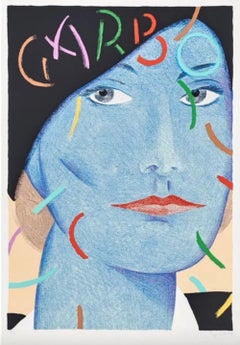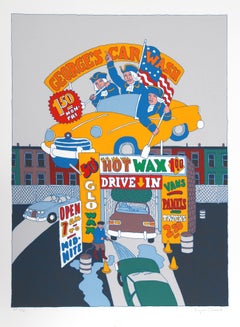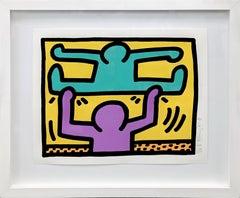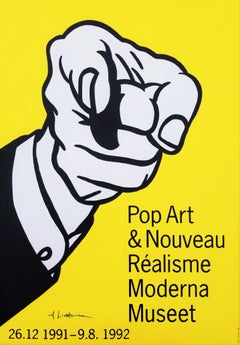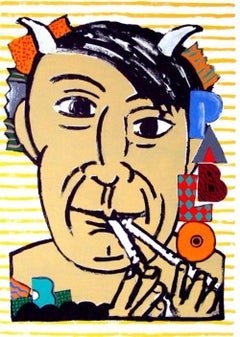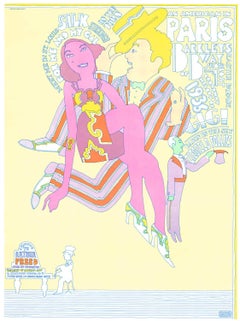Seymour Chwast Figurative Prints
American, b. 1931
Seymour Chwast's posters are in the permanent collections of many museums worldwide. Seymour Chwast"s art helped to propel a revolution in American illustration during the early 1960"s from sentimental realism to comic expressionism. His work for magazines, posters, advertisements, and children"s books influenced at least two generations of illustrators and designers in America and abroad to explore a broad range of stylistic and conceptual methods, as well as to wed illustration with design. In addition to his unique style and innovative techniques, Chwast contributed a delightfully absurdist sense of wit and humor to twentieth century applied art. Although rooted in the decorative traditions of the nascent years of commercial art—notably Victorian, Art Nouveau, and Art Deco—his work is not a synthesis of the past and present, but an invention of the most original kind.to
1
1
Overall Width
to
Overall Height
to
2
27
847
382
381
308
2
1
1
2
2
2
2
1
1
1
1
1
1
1
2
2
Artist: Seymour Chwast
Greta Garbo
By Seymour Chwast
Located in New York, NY
Seymour Chwast
Greta Garbo, 1989
Silkscreen on Rives BFK
Hand-signed and numbered 36/200 by artist on the front
44 x 30 inches
Unframed
This large, dazzling multi color silkscreen is...
Category
1980s Pop Art Seymour Chwast Figurative Prints
Materials
Screen
George's Car Wash, Pop Art Screenprint by Seymour Chwast
By Seymour Chwast
Located in Long Island City, NY
Artist: Seymour Chwast, American (1931 - )
Title: George's Car Wash
Year: Circa 1978
Medium: Screenprint, signed and numbered in pencil
Edition: 250, AP 50
Image Size: 30.5 x 23 ...
Category
1970s Pop Art Seymour Chwast Figurative Prints
Materials
Screen
Related Items
“Untitled” from Pop Shop I
By Keith Haring
Located in Aventura, FL
Hand signed, numbered, and dated by the artist. Screenprint in colors, on wove paper, with full margins, Image size 10.5 x 13.375 inches.. Sheet size 12 x 15 inches. Frame size approx 17.25 x 20.25 inches Littmann p. 83. Published by Martin Lawrence...
Category
1980s Pop Art Seymour Chwast Figurative Prints
Materials
Paper, Screen
Pop Art & Nouveau Réalisme Moderna Museet (Finger Pointing) Poster (Signed)
By Roy Lichtenstein
Located in Saint Augustine, FL
Artist: (after) Roy Lichtenstein (American, 1923-1997)
Title: "Pop Art & Nouveau Réalisme Moderna Museet (Finger Pointing)"
*Signed by Lichtenstein in...
Category
1990s Pop Art Seymour Chwast Figurative Prints
Materials
Screen
$8,000
H 39.38 in W 27.63 in
Heart & Soul
By Mr. Brainwash
Located in New York, NY
Heart & Soul, 2020
Signed, dated, numbered in pencil with thumbprint in verso
Screenprint on paper
30 x 22 inches
Edition 84 of 85
Category
2010s Pop Art Seymour Chwast Figurative Prints
Materials
Screen
POP SHOP QUAD III
By Keith Haring
Located in Aventura, FL
Screenprint in colors, on wove paper. Stamped with the artist's estate and signed, dated and numbered by the executor, Julia Gruen, in pencil on the rever...
Category
1980s Pop Art Seymour Chwast Figurative Prints
Materials
Paper, Screen
Les Mondrian Ladies (large custom framed hand signed serigraph)
By Peter Max
Located in Aventura, FL
Serigraph in colors on paper. Hand signed lower right by Peter Max. Hand numbered PP lower left (there is also a main edition of 300). Sheet size: 30 x 40 inches. Custom framed a...
Category
1980s Pop Art Seymour Chwast Figurative Prints
Materials
Paper, Screen
$3,500 Sale Price
30% Off
H 40 in W 50 in D 1 in
Kunsthalle Bern (Hopeless) Poster /// Pop Art Roy Lichtenstein Screenprint Huge
By Roy Lichtenstein
Located in Saint Augustine, FL
Artist: (after) Roy Lichtenstein (American, 1923-1997)
Title: "Kunsthalle Bern (Hopeless)"
Year: 1968
Medium: Original Screenprint, Exhibition Poster o...
Category
1960s Pop Art Seymour Chwast Figurative Prints
Materials
Screen
$4,500
H 50.5 in W 35.75 in
Olivia 1
By Alex Katz
Located in Boca Raton, FL
This work is edition number 33/50. Signed/numbered in pencil, lower lect.
By reducing his subjects to their most essential visual components, Alex Katz engages in a reductive proc...
Category
21st Century and Contemporary Pop Art Seymour Chwast Figurative Prints
Materials
Screen
Dancer 1
By Alex Katz
Located in New York, NY
Alex Katz
Dancer 1
2019
Silkscreen in colors on Saunders Waterford HP High White 425 gsm paper
60 x 36 inches (153 x 92 cm)
Edition of 60
Category
2010s Pop Art Seymour Chwast Figurative Prints
Materials
Screen
Bert Stern "Marilyn Monroe Gold and Champagne" 1973 Signed Photo Silkscreen
By Bert Stern
Located in Miami, FL
BERT STERN – "MARILYN MONROE (GOLD/CHAMPAGNE)"
Photo Silkscreen ⚜ Hand Signed ⚜ Numbered ⚜ Framed
AN ICONIC IMAGE FROM "THE LAST SITTING" SERIES
This original photo silkscreen by Be...
Category
1970s Pop Art Seymour Chwast Figurative Prints
Materials
Photographic Paper, Screen
$9,000
H 39 in W 39 in D 1.25 in
Pop Art Portrait of Kate Moss, Black & White Screen Print
By Marc Foster Grant
Located in Soquel, CA
Pop Art style portrait of a woman with a likeness to Kate Moss by Marc Foster Grant (American, 20th Century). Unsigned, from a collection of his work...
Category
Late 20th Century Pop Art Seymour Chwast Figurative Prints
Materials
Paper, Screen
$1,150
H 30 in W 23 in D 0.07 in
Alex Katz 'Olivia 2'
By Alex Katz
Located in New York, NY
"Olivia 2" by Alex Katz (2025) is a striking multicolored screen print on Museum quality fine art paper, signed and numbered in a limited edition of 50, showcasing Katz's iconic styl...
Category
2010s Pop Art Seymour Chwast Figurative Prints
Materials
Screen
NICK SMITH - BEAUTY. Limited edition hand signed Pop Art Design Modern
By Nick Smith
Located in Madrid, Madrid
NICK SMITH - BEAUTY
Date of creation: 2022
Medium: Giclée and screen printed varnish on paper
Edition: 66
Size: 62 x 60 cm
Condition: Brand new, in mint conditions and never framed
...
Category
2010s Pop Art Seymour Chwast Figurative Prints
Materials
Varnish, Archival Paper, Giclée, Screen
$4,425
H 24.41 in W 23.63 in
Previously Available Items
Pablo Picasso
By Seymour Chwast
Located in New York, NY
Seymour Chwast
Pablo Picasso, 1989
Silkscreen on Rives BFK
Hand-signed and numbered 36/200 by artist on the front
44 x 30 inches
Unframed
This dazzling oversized silkscreen with deck...
Category
1980s Pop Art Seymour Chwast Figurative Prints
Materials
Screen
Original "A Tribute to Arthur Freed" vintage poster Broadway
By Seymour Chwast
Located in Spokane, WA
Original "A Tribute to Arthur Freed, June 20 - August 20, Gallery of Modern Art, New York, vintage poster. 1967. Artist: Seymour Chwast. Linen backed in A- condition, ready to frame.
Arthur Freed (1894 – 1973)] was an American lyricist and Hollywood film producer. He won the Academy Award for Best Picture twice, in 1951 for An American in Paris...
Category
1960s 85 New Wave Seymour Chwast Figurative Prints
Materials
Screen
H 40 in W 29.5 in D 0.05 in
Seymour Chwast figurative prints for sale on 1stDibs.
Find a wide variety of authentic Seymour Chwast figurative prints available for sale on 1stDibs. You can also browse by medium to find art by Seymour Chwast in screen print and more. Much of the original work by this artist or collective was created during the 20th century and is mostly associated with the Pop Art style. Not every interior allows for large Seymour Chwast figurative prints, so small editions measuring 26 inches across are available. Customers who are interested in this artist might also find the work of Ronnie Cutrone, John Brower, and Rainer Gross. Seymour Chwast figurative prints prices can differ depending upon medium, time period and other attributes. On 1stDibs, the price for these items starts at $700 and tops out at $1,250, while the average work can sell for $750.
